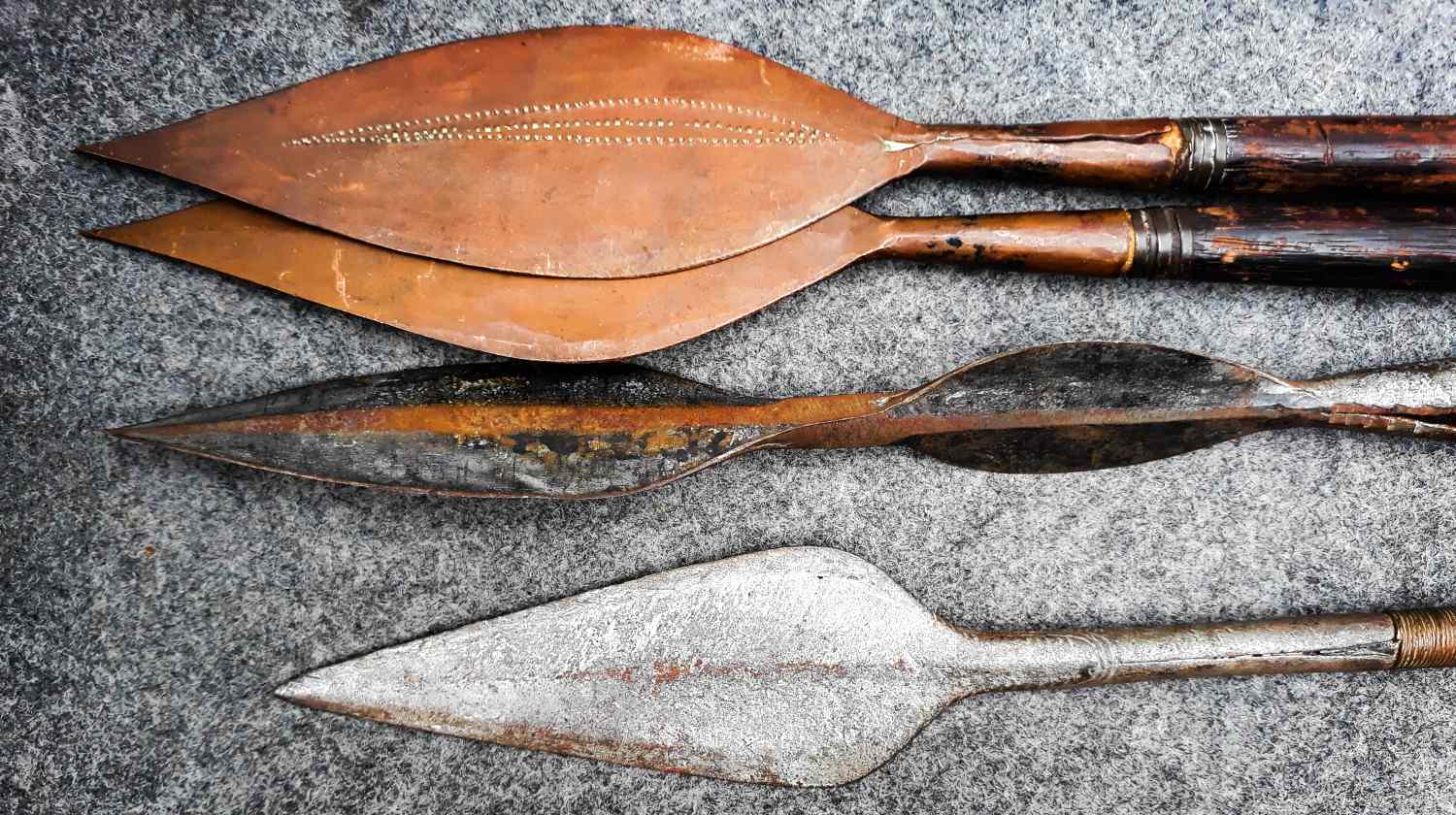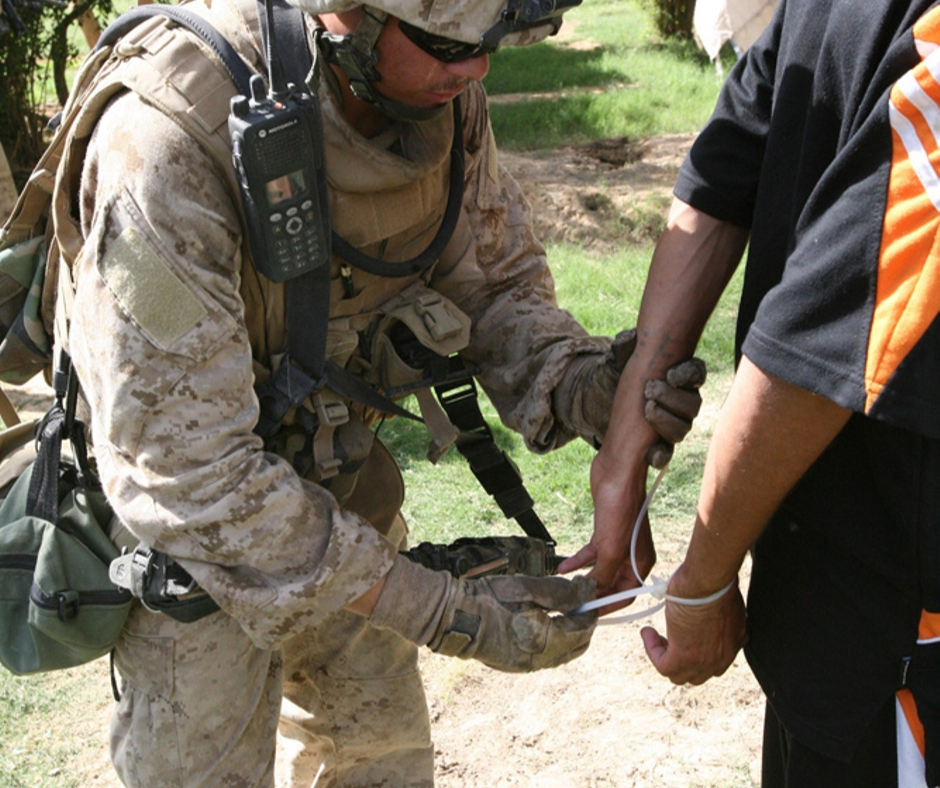Homemade Survival Equipment
How To Make A Spear | DIY Survival Spear
Whether you’re in an authentic survival scenario or just up at the lake for a weekend camping trip, you’ve got to eat. But what if your food supplies are running low, or worse, you never had any to begin with? That’s where your survival spear comes in.

Learn how to make a spear with this guide so you can hunt or defend yourself in a survival situation.
RELATED: 20 Essential Homemade Weapons For When SHTF
In this article:
- Learning How to Make a Spear Is a Must for Survivalists
- How to Make a Spear for Food and Self-Defense
How to Make a Spear for Self-Defense and Survival
Learning How to Make a Spear Is a Must for Survivalists
Whether you’re in an authentic survival scenario or just up at the lake for a weekend camping trip, you’ve got to eat. But what if your food supplies are running low, or worse, you never had any, to begin with?
That’s when knowing how to make a spear comes in handy. Here, we’re going to show you how to make a hunting spear from wood.
We’ll also offer some basic fire-hardening techniques to prolong the life of your spear. Stick around to the end to learn the most effective way to make this multifunctional, primitive hunting tool.
Along the way, we’ll pass on some important safety warnings and tips. Before you get started, here are a few things you’ll need:
1. Spear Pole
|
We recommend a small, green sapling approximately 2 – 2.5 inches in diameter, and a few inches taller than you are. (We’ll tell you why later.)
Tip: When choosing a tree for your spear pole, choose as straight a sapling as possible. We recommend hardwoods such as hickory, oak or maple.
2. Sturdy Baton Stick
Hardwood works best as a baton. This is essentially an improvised hammer and will serve to help provide an effective downward force to split your spear into segments without breaking it.
These can easily be found on the forest floor or you could even use a leftover piece of your sapling if it’s thick enough. Make sure it is not rotten, as a rotten log will simply fall apart.
You can easily tell if the baton is rotten with a few quick, solid thumps against a tree stump. If it doesn’t shatter, you should be good to go!
3. Strong Cordage (2-3 feet)
Paracord is my cordage of choice due to its strength, durability, and resistance to rot in damp conditions, but any cordage can work in a pinch (Even your shoelaces)!
Tip: You can never have enough cordage in a survival situation… you might just be surprised at how many different uses you can find for it!
This tactical fish survival kit has 9′ of genuine paracord, perfect for your spear making.
4. Folding Saw
|
A strong serrated knife will work… but having a pocket folding saw will save you a ton of time, work and hassle! Another secondary option would be a pocket chainsaw or even a wire saw.
In my opinion, however, no good survival or camping kit is complete without a folding pocket saw. Here’s a good one to grab.
5. A Good, Full Tang Fixed Blade Knife
When it comes to splitting or batoning wood, a folding knife just won’t cut it! It’s dangerous to try and will absolutely ruin your knife.
Do yourself a favor and, before you ever head out, get your hands on a solid, full tang fixed blade knife… you won’t regret it.
Check out my favorite knife, it’s the #1 tactical folding knife in the world.
RELATED: 14 Homemade Weapons That Are REALLY Badass [2nd Edition] | Survival Life
How to Make a Spear for Food and Self-Defense
Step 1. Prepare Your Pole
Once you’ve cut your pole, saw off the fat end to make the surface flat and even. Take your cordage and wrap the pole about 10 inches below the working end.
This will help keep the pole from splitting out once you begin the batoning process.
WARNING: Make sure your spear stands at least as tall as you do. This will help ensure the sharpened points of your spear are above eye level, just in case you take a fall while out on the hunt.
Step 2. Split and Sharpen the Working End of Your Spear
Once you’ve wrapped the working end of the spear with cordage, butt the opposing end up against a tree or stump to help stabilize it. Slowly baton 8-10 inches straight down.
Turn your knife perpendicular to the first split and repeat the batoning process.
Next, find a couple of three-inch sticks about the diameter of a pencil and slide them firmly in place between the splits to keep the spear points expanded. With your knife, sharpen each of the four points.
Step 3. Harden the Spear’s Points with Fire
Once the points are sharp, remove the cordage and place the sharpened points below the coals of a fire for 10-15 minutes. This speed dries or “fire-hardens” the wood.
Tip: Be mindful of your spear during this process; check it often to make sure it’s only drying and not burning.
Side Note: An alternative drying technique is to hold the spear just above the flames of your fire like a marshmallow so the flames lick the points of the spear.
While this technique may take longer, it’s easier to keep an eye on the spear points to make sure they aren’t burning.
Step 4. Reinforce the Spear
Once the spear is removed from the fire and allowed to cool, latch the three-inch wooden pegs in place to reinforce the spear during impact. Align your cordage vertically against the shaft of the spear and create a loop.
Next, wrap cordage around the shaft while alternating over and under the wooden pegs.
Step 5. Finishing Touches
After two or three times around, slip the working end of your cordage through the loop you created earlier, and give a stout tug on the other end. When done correctly, this will tighten the pegs up nicely and leave you with a durable, four-prong spear point.
You can also opt to sharpen the other end of the spear into a single, fire-hardened point for self-defense against potential predators.
Watch this video from AVmake for an alternative which is how to make a spear for fishing out of bamboo:
There you have it, survivalists! A sturdy spear good for self-defense and harvesting small game and fish. Your DIY survival spear will work great to take down small game and fish, but when it comes to larger game you’ll need a more heavy-duty weapon.
What do you think of our tutorial on how to make a wooden spear? Sound off in the comments section below!
Up Next:
- Make Your Own Compound Bow with Just a Few Supplies
- Homemade Weapons You Can DIY To Awaken Your Inner Caveman
- 7 Self-Defense Martial Arts For Personal Safety And Survival
Follow us on Facebook, Instagram, Twitter, Pinterest, and Tumblr!
**Disclaimer: All content on this site is for informational purposes only. Please read our full disclaimer here**
Editor’s Note: This post was originally published on March 31, 2016, and has been updated for quality and relevancy.
-

 Do It Yourself7 months ago
Do It Yourself7 months agoParacord Projects | 36 Cool Paracord Ideas For Your Paracord Survival Projects
-

 Do It Yourself9 months ago
Do It Yourself9 months agoHow To Make Paracord Survival Bracelets | DIY Survival Prepping
-

 Do It Yourself9 months ago
Do It Yourself9 months ago21 Home Remedies For Toothache Pain Relief
-

 Do It Yourself10 months ago
Do It Yourself10 months agoSurvival DIY: How To Melt Aluminum Cans For Casting
-

 Exports8 months ago
Exports8 months agoAre Switchblades Legal? Knife Laws By State









Pingback: How to Make a Fishhook From Natural Materials
Pingback: DIY Fishing Pole from a Stick | Survival Life | Blog
Pingback: DIY Alcohol Stove from a Beer Can | Survival Life | Blog
Doc
February 9, 2017 at 8:10 AM
Poor design. If used as a fish or frog gig, it needs some form of barbs to keep fish on the spear, rather than killing it and allowing it to slide off and be lost. Point deployment too widely spaced to be effective on small game. Bette one good single point, with a barb notched in. I have made these weapons for years, and harden them over the flames. An atatl would be a good addition.
davidesionjr
February 9, 2017 at 1:16 PM
Any good tutorials on making a barbed point spear or atatl?
cliffarif
February 9, 2017 at 2:20 PM
Just think of a trident, barb on the left side, barb on the right side, and an arrow in the middle.
equestrian_colt
February 9, 2017 at 9:03 AM
Pretty ingenious.
cliffarif
February 9, 2017 at 2:42 PM
And here I thought the tutorial was going to show us how to make a spear. Well do everything as shown until you make the perpendicular split. With the first split you insert your knife or sharpen stone into the slit. You then use your cordage and tie it tightly around the end of of your spear. If you have any wiggle room between the knife and spear shaft just insert a pencil size stick between the knife handle and the outside of the shaft. Do this to the other side so that it will be even. Then tie your cordage around the end of the spear shaft. Make sure you do it tight. Now you have a spear. Oh yea, do not sharpen the other end unless you are experienced enough to throw the spear without stabbing yourself.
If you are not willing to use a knife as your point on a spear, the just sharpen the end of your spear then harden it by creating a charcoal tip. Charcoal tip is harden wood and very effective way to have a fine point on your spear. All you have to do is to allow it to dry out in the fire by rolling it against a rock turning black. Don’t let it catch on fire too long otherwise it will just become another piece of firewood.
If you want a gig then think of a trident. See my comments below. A trident is an excellent way to catch fish and small game.
Arizona
February 17, 2019 at 11:27 AM
nice instructions on making a spear. however i find it troubling that the author can’t seem tell the difference between a hidden tang knife, as pictured in this article, and full tang knife, what’s sold by tops knives.
putting it another way: if it’s encased in the grip material, it’s a hidden tang. if the grip consists of two scales mechanically fastened by rivets, pins, screws or even epoxy and rods, it’s a full tang. oh and the terms “partial”, “half” and “through” mean bugger all as regards to it being hidden or full. they simply tell you how far into the grip the tang extends
Pingback: How To Make A War Hammer -